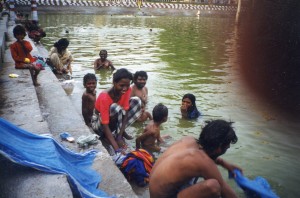I said that the last post on the Rg Veda was the final one, but nothing is final in the Rg Veda.
The Rg Veda began a tradition that still lives. It’s India’s most prevalent spiritual and literary tradition. More and more meanings were found in the Rg Veda.
In the West, a text is usually considered a single work. But the Rg Veda was expanded into an enormous corpus of literature that grew for more than 2,000 years.
1. First the three other vedas were composed. The Sama Veda is a collection of melodies that Vedic hymns can be sung to.
The Yajur Veda includes short prose formulas that a priest would pronounce during the rituals.
The Athara Veda was focused on magical and healing rites.
2. The Brahmanas were than added to the Vedas, and they detail correct ritual performances.
3. The Aranyakas and Upanisads were than written. The Upanisads were philosophical reflections on the Vedas outside of performances.
Do you think those are enough extensions for one text? Not in India:
4. The Vedangas were written, and they’re the 8 disciplines that arose from Vedic ritual. For example, the Nirukta is about word origins–it speculates about the origins of words in the Vedas.
So Vedic literature went on and on.
And on.
5. The Ramayana and Mahabharata have been seen as rooted in it.
6. One of the main philosophic schools, the Mimamsa, was about the correct adherence to Vedic traditions.
Actually there were 2 Mimamsas, the Purva (early) and Uttara. They set out to defend the Vedas from Buddhists who asserted that nothing exists but consciousness.
7. Tamil poetry began to flourish nearly 2,000 years ago, and theorists said that it’s rooted in the Vedas, even though the Tamil language isn’t in the Sanskrit family. It’s one of the 4 main southern languages.
What gives? We can note three things:
1. Westerners have usually considered a text to be a bound work, with a beginning and conclusion. When you finish it, it’s history. You pick up another work and read it. Both texts are distinct entities. Homer’s poems are stories with endings. But the Vedas have unbounded continuity. They express different assumptions about what a text is: an emanation from the immense metaphysical background that all life forms emerged from.
2. This corpus has been a major unifier of Indian culture. India has usually been politically divisive. Even Ashoka (3rd century BCE) and the great Gupta dynasty (4th and 5th centuries CE) didn’t rule the whole sub-continent. This immense body of literature has been a bigger locus of unity. It generated many pan-Indian ideas and arts that spread beyond Sanskrit speaking regions.
3. The vastness of Vedic literature has encouraged tolerance of many faiths–anything can be absorbed into the Vedic tradition. The Buddha was ultimately seen as just one of Vishnu’s many incarnations.
So like many things in India, texts can expand to the dimensions of the whole universe.
This way of seeing the world in terms of a vast unity, rather than the distinct entities and proportions that ancient Greek thought gravitated towards, was also encouraged by the subcontinent’s indigenous traditions. Vedic society merged with them when it settled in India around 1500-1000 BCE. This chemistry between these two societies created one of the world’s greatest cultural well-springs, which we’ll explore in future posts.
Also see The Rg Veda, Roots of Indian Culture; Part One.
For a view of a different southern Asian culture, which is equally rich, see Thailand.


Comments on this entry are closed.